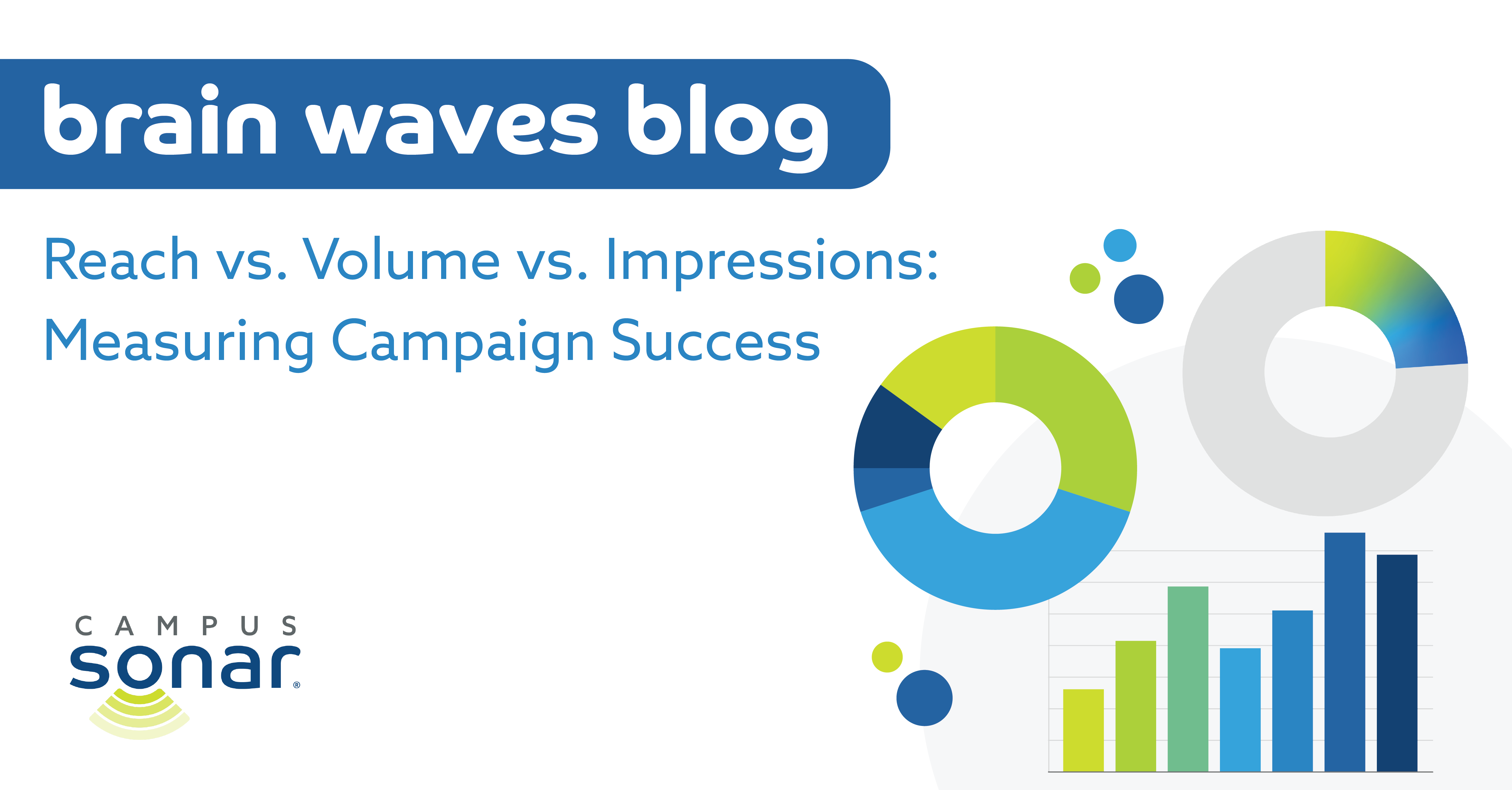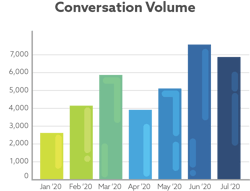Reach vs. Volume vs. Impressions: Measuring Campaign Success

At Campus Sonar, our humans set us apart. Our experience researching and analyzing the nuances of online conversation means we understand how to measure the effectiveness of your content. We know how to analyze who sees your content and understand how that’s impacted by each platform. When you develop social media strategy and create corresponding campaigns, this is ultimately what you need to measure to show success, right? The effectiveness of your campaign. If it worked.
As you develop your social strategy and content, your purpose and goal are critical. You need to know what you're trying to achieve. If your campaign goal is brand awareness, volume or reach might be the best measurement. But they’re not great success measures for a recruiting campaign where you’d use application clicks, form submissions, or campus visits scheduled to measure effectiveness.
Ways to Measure Success
Once you know your goal, you can determine how you’re going to measure your campaign’s success.
How Many People Talk About Your Content
One way is the volume of conversation. It measures the size of the conversation about your brand or campaign during a certain time period—so the number of times your campaign content is mentioned in online conversation. When you’re trying to expand awareness of your brand or specific messaging, volume can be an indication of progress toward that goal. Monitoring your conversation is also valuable in understanding how conversation volume and trends change over time.
How Many People See Your Content
Another way to measure success is by the reach of your campaign. Reach is the number of people who see your content. Reach estimates are calculated by how much a post is engaged with and the average traffic or audience stream for the site or author. The reach score translates the metrics attached to a particular post into a value to compare it across all data sources. This allows you to compare the reach of content from different platforms and track development over time.
Reach is tracked at the mention level, in other words it’s calculated for each specific post or tweet. But it can also be summed across a campaign to estimate how many people saw the campaign content. Reach is a useful tool for understanding what specific content performs well within particular audiences, and you can use it to help inform future content.
How Many Times Your Content Is Displayed
Impressions are the number of times your content is displayed. It doesn’t consider if the content was clicked or not, which is how the metric differs from reach. If you use impressions as a metric, it has the potential to over inflate the value of follower quantity versus follower quality. If you’re trying to understand a campaign’s success at capturing audience awareness, it’s more valuable to use the volume of conversation than the number of potential impressions.
This may conflict with what you’re used to, as impressions or reach are a common metric displayed in most social media and social listening platforms.
Measuring Across Platforms
Another consideration in measuring success is that different platforms measure reach and impressions differently.
Reach
- Twitter: The total number of people who may have seen your post.
- Instagram: The number of users who saw your post or story on a given day.
- Facebook:
- Organic: The number of people who saw your free content in their News Feed.
- Paid: The number of people who saw your paid content.
- Viral: The number of people who saw your post in a story published by a friend, as a result of liking, sharing, or commenting.
- Social Listening Software: The number of users who may have seen an individual post, calculated by estimating how many of the author’s followers would see the post, based on post engagement, and the followers of anyone who retweeted or commented on the original post. On platforms other than Twitter, reach is calculated using engagement, where possible, and average site traffic.
Impressions
- Twitter: The number of times an individual post is displayed, which means people could potentially see it more than once. This includes not only the times it appears in one of your followers’ timeline but also the times it appears in search or as a result of someone liking the Tweet.
- Instagram: The number of times your content was shown to users.
- Facebook:
- Organic: The number of times your content was displayed for free.
- Paid: The number of times your paid content was displayed.
- Viral: The number of times content from your page was displayed in a story published by a friend, as a result of linking, sharing, or commenting.
- Social Listening Software: The number of times an individual tweet is displayed, as calculated by summing author and retweeter followers plus number of times the tweet is returned as a result of a search.
For example, if a campus is retweeted by an organizational twitter account, the retweet may generate 50,000 impressions. This number looks great on paper, but in reality it's not a focused audience. And the reach for the content is only a small fraction of those 50,000—these are the people who actually see the content. To dig even deeper, a fraction of those who see the content actually care about it or remember it. So you’re looking at a fraction of a fraction—not very meaningful, right?
Take a look at this mention of Lehigh University that tags their official account. The mention had approximately 1,200,000 impressions, but the post is one many users may ignore as they scroll through their timeline.
Beyoncé or @LehighU?
— Portland Trail Blazers (@trailblazers) June 16, 2018
We asked @CJMcCollum the tough questions in his personal Bracket Challenge. pic.twitter.com/ZSRryhbOwm
Another mention from a graduate student at Lehigh is genuine and relatable. It’s a mention that users are more likely to engage with because they connect with the content. This mention had just over 1,000 impressions, a small fraction of the previous example.

It’s unlikely that the Portland Trailblazers have a lot of followers that are part of Lehigh’s target audience, or are likely to engage in brand messaging. The tweet from the PhD student has a personal connection to Lehigh, and the 48 people who liked the post are probably more likely to be a part of Lehigh’s target audience. The person who tweeted has less than 50 followers, so the percentage of followers and others who interacted with this tweet is notable. At the very least, these mentions should be evaluated based on Lehigh's desired outcome. If the goal is recruiting, the tweet from the PhD student with high engagement is likely to be more effective (especially if the PhD student is part of their target audience). If the goal is broad brand exposure, the Trailblazers tweet will have more impact.
The unique engagement in a campus’s online conversation is the meaningful metric that demonstrates your success, but the value is often overshadowed with a metric like impressions because it’s generally a much larger number. Ultimately, the distinction between impressions and conversation volume comes down to measuring potential audience versus engaged audience. Conversation volume allows you to measure those who actively engage with (and potentially amplify) your content. It measures the number of people talking about your campus and tracks it over a period of time.
Impact Score—Another Helpful Metric
In addition to conversation volume, we also use our social listening software's impact score to assess a campaign across social media platforms. It helps us drill down to better understand a campaign’s success.
Impact score measures the degree of overall engagement with a mention. It measures the impact of a mention relative to the population of mentions from the same content source.
- To calculate impact score, the software's algorithm analyzes the available metrics and allocates a score (1 to 100) to each mention based on how it rates against average engagement from that particular content source.
- The benefit is that you can compare impact scores across different content sources and platforms.
- An example of impact score is if you wanted to measure the impact of your owned social media mentions. This metric allows you to identify the content you generate that resonates on particular sites, as well as the type of content that receives the most engagement. Knowing the impact score helps you achieve your goals.
We take all of these factors into consideration when we perform social listening analysis, including how platforms calculate the data. We share the most meaningful results with our clients and audiences, informing them of the metrics we’re using, just as you inform your stakeholders of the metrics you use. Having a solid, shared understanding of the meaning behind the metrics you use makes it clearer to you, your team, and your stakeholders if your campaigns successfully meet your goals.
Expand Your Knowledge
Discover how to understand your audience better, craft messaging that resonates with them, and position your institution to get noticed in all the right ways.

